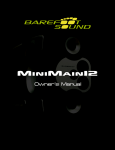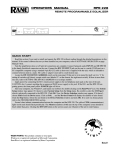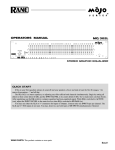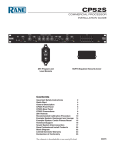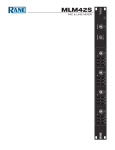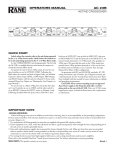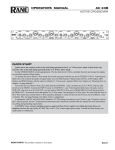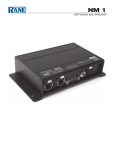Download Rane VP 12 Operating instructions
Transcript
OPERATORS MANUAL VP 12 VOICE PROCESSOR QUICK START Even if you don’t like to read manuals, read this part. We’ll make it quick and painless. We promise. Turn down (fully counterclockwise) the MIC INPUT GAIN and both MAIN and AUX OUTPUT LEVEL controls. Set the LOW CUT FILTER to 10 (fully CCW) and the HI CUT FILTER to 40k (fully CW). Depress all BYPASS switches on the front panel. If you are using a mic, connect it to the MIC IN jack located on the rear of the unit. If your mic requires phantom power, press the rear panel 48V PHANTOM POWER switch. If you are using a line level source (like the output of a wireless mic receiver), connect its output to either the ¼" TRS jack or the screw terminals located on the rear of the unit labeled LINE/ EXPAND IN. Leave all jumpers located on the long screw terminal patch strip in the original factory shipped position. These positions guarantee you access to all the features of the VP 12. Connect the Outputs of the VP 12 to your mixer board or recorder. The switch located directly next to the XLR MAIN OUT jack converts the MAIN OUTs to either a MIC or LINE level output, depending on your driving requirements. The AUX OUT of the VP 12 is only line level. WEAR PARTS: This product contains no wear parts. Plug the included power supply (see italics below) into the VP 12. The yellow PWR LED will illuminate if all is well. Now warn everyone else around, and yell into your mic the loudest sound you expect during your session or performance. While doing this adjust the INPUT GAIN control so that the loudest sounds will occasionally illuminate the OL LED. If you are using the LINE IN, adjust the output level of the previous device to occasionally illuminate the OL LED of the VP 12 when the loudest signal you expect to hear is present. Adjust the VP 12 OUTPUT LEVEL controls to match the device you are driving. Now taking one processing section at a time, release its BYPASS switch and adjust the processing controls. Any number of processing sections may be IN or BYPASSED to isolate different parameters. For details on setting these properly see OPERATING INSTRUCTIONS on the last two pages. Never connect anything except an approved Rane power supply to the thing that looks like a telephone jack on the rear of the VP 12. This is an AC input and requires special attention if you do not have an operational power supply EXACTLY like the one originally packed with your unit. Manual- FRONT PANEL DESCRIPTION 1 OL (overload) indicator LED. Illuminates (red) any time the signal is within 4 dB of overloading. Five locations are monitored. See the block diagram with the schematics elsewhere in this manual. 2 PWR (power) indicator LED. Illuminates (yellow) when power is connected. Use only an approved RANE AC remote supply such as an RS 1 (included) or RAP 10. 3 MIC INPUT GAIN control. Increases mic input gain as it is rotated clockwise. It’s range is 15 dB of gain at full CCW rotation to 60 dB at full CW rotation. 4 MIC INPUT SELECT switch. In the LINE position, the signal entering LINE/EXPAND IN is active. In the MIC position the signal entering the MIC IN is active. In the BOTH position both LINE and MIC signals are summed together. Level matching between LINE and MIC signals must be done externally in the SUM BOTH position. 5 LOW CUT filter. Defines the low cut-off frequency. In the full CCW position the LOW CUT filter is essentially out of the signal path. 6 HI CUT filter. This control defines the high cut-off frequency. In the full CW position the HI CUT filter is essentially out of the signal path. 7 DE-ESS BYPASS switch. When this switch is in the DE-ESS function of the VP 12 is not functional and the DE-ESS controls will do nothing. DE-ESS is active in the out position. 8 DE-ESS FREQUENCY. This control determines the range of frequency that the DE-ESS circuit is sensitive to. In practice it is best to set this to the highest frequency that will provide the amount of DE-ESSING you require and no lower. The lower the frequency setting the less transparent the DE-ESSING function becomes. 9 DE-ESS RATIO. This three-position switch determines the rate at which the DE-ESS filter responds to expected sibilance. The NORM setting is best for most situations. 0 DE-ESS THRESHOLD control and LED. This control sets the signal level in dBu above which the DE-ESS function becomes active. When the LED is lit, the threshold has been exceeded and the DE-ESSER is doing its thing. Manual- q GATE/EXPANDER and COMPRESSOR BYPASS switch. When this switch is in the GATE/EXPANDER and COMPRESSOR functions are inactive and the corresponding controls do nothing. With the switch in the out position these circuits are active. w GATE/EXPANDER THRESHOLD control and LED. This sets the input level below which the GATE/EXPANDER function operates. The LED illuminates any time the signal falls below the threshold set by the control. e GATE RATIO switch. This switch determines the ratio to be applied to the GATE/EXPANDER function. Higher ratios mean steeper drop-off slopes, lower ratios are usually more transparent. r COMPRESSOR THRESHOLD control and LED. This determines the input level above which the compressor functions. Full CW rotation disables the COMPRESSOR entirely.This LED illuminates any time the signal exceeds the threshold set by the control. t COMPRESSOR RATIO control. This determines the slope of compression once the threshold has been exceeded. Full CCW rotation effectively disables the compressor. y GAIN REDUCTION METER. This seven-segment meter indicates the amount of signal reduction, below unity, applied to the audio signal by both the GATE/EXPANDER and COMPRESSOR. The GATE/EXPANDER & COMPRESSOR BYPASS switch has no effect on this meter, as it still shows gain reduction at current settings. u EQ bypass switch. When this switch is in, the EQ section is not functional and the corresponding controls do nothing. In the out position the EQ is active. i EQ FREQUENCY control. This determines the center frequency of the bandpass equalizer. o EQ FREQUENCY RANGE switch. This is a multiplier for the EQ FREQUENCY control. This allows each EQ to cover the full audio range and still provide excellent resolution with a single EQ FREQUENCY control. p EQ LEVEL control. This determines the amount of boost or cut applied to the audio signal. When this control is in the center detent, this band of EQ is has no effect on the signal path. When this control is in grounded center detent, the band of the EQ is out of the circuit. Manual- REAR PANEL DESCRIPTION POST PROCESSOR IN POWER COMMON COMPRESSOR/GATE PATCH SIDE CHAIN PATCH EQ PATCH DE-ESS PATCH PRE PROCESSOR OUT VP 12 BALANCED WIRING: PIN 2/TIP=POSITIVE PIN 3/RING=NEGATIVE PIN 1/SLEEVE=CHASSIS GND LINE/EXPAND IN (USE ONLY ONE) MADE IN U.S.A. RANE CORP. 48V PHANTOM POWER MAIN OUT LEVEL BALANCED 600mA CLASS 2 EQUIPMENT LINE MIC MAIN OUT + - CHAS GND - AUX OUT + CHAS GND OUT IN OUT CHAS GND IN OUT IN OUT IN CHAS GND ACN001.187.837 + CHAS GND - MIC IN 1 GROUND connector. Since the VP 12 is powered from a remote AC supply which does not carry chassis ground through to the grounding pin of the AC line cord, this screw has been provided in case your system does not have another earth grounding means such as through rack rails, etc. Its use or disuse should be determined by your specific application. 2 REMOTE AC POWER input. The VP 12 is supplied from the factory with a Model RS 1 Remote Power Supply suitable for connection to this input jack. The power requirements of the VP 12 call for an 18-24 volt AC center-tapped transformer only. This is not a telephone jack. Never use a power supply with your VP 12 other than the one supplied or an exact replacement obtained from or approved by Rane Corporation. Using any other type of supply may damage the unit and void the warranty. Two years parts and labor is worth safeguarding, don’t you think? A three year warranty is available by completing and mailing in the warranty card, before something goes wrong. 3 MAIN OUT LEVEL switch. Sets the output level for the MAIN output, LINE or MIC level. 4 MAIN and AUX OUTPUT XLR jacks. Are fully balanced outputs, controlled by the front panel OUTPUT LEVEL. Pin 2 is positive, pin 3 is negative and pin 1 is chassis ground. When driving high impedance loads, both screw terminals and XLR jacks can be used at the same time. 5 MAIN and AUX screw terminal outputs. Deliver the same outputs as the XLR connectors above. 6 Screw terminal patch strip. Configured from the factory with all functions active, in the same order as the front panel. These terminals allow the disabling or re-arranging of functions. This also allows a function block, such as the EQ, to patch into and out of the VP 12 to an external processor or mixing channel. The factory jumper positions are illustrated below. 7 LINE/EXPAND IN screw terminals and ¼" TRS jack. This is a line level balanced input. Tip is positive, ring is negative and sleeve is chassis ground. Do not use both screw terminals and the ¼" TRS jack simultaneously. They do not sum. 8 MIC input. A fully balanced Mic level input. Pin 2 is positive, pin 3 is negative and pin 1 is chassis ground. 9 48V PHANTOM POWER switch and LED. When this switch is in, 48 VDC is fed to the MIC IN jack and the LED is lit. POST PROCESSOR IN CHAS GND COMPRESSOR/GATE PATCH SIDE CHAIN PATCH EQ PATCH OUT IN OUT CHAS GND IN OUT DE-ESS PATCH IN VP 12 Factory Jumper Positions Manual- OUT PRE PROCESSOR OUT IN CHAS GND VP 12 CONNECTION OPERATING INSTRUCTIONS When connecting the VP 12 to other components in your system leave the power supply for last. This gives you a chance to make mistakes and correct them before any damage is done to your fragile speakers and nerves. The MIC input of the VP 12 is balanced and accepts a standard XLR cable from the MIC of your choice. As with all Rane products and AES standards, pin 2 is used for “hot” or “+” polarity, pin 3 is “return” or “–” and pin 1 is chassis ground. If you are not using PHANTOM POWER you may use either pin 1 or case for shield ground on the VP 12 input. However, if you are using PHANTOM POWER, pin 1 must be shield grounded to provide a complete electrical circuit. The LINE/EXPAND input of the VP 12 is also balanced, as a TRS jack or screw terminals. Choose one, these do not sum. The tip is “+”, the ring is “–”, and the sleeve is chassis ground. Unbalanced wiring such as a standard ¼" TS plug may also work, but with possible compromises in level adjustments. Outputs on the VP 12 are fully balanced. As expected, pin 2 is “hot” or “+”, pin 3 is “return” or “–” and pin 1 is chassis ground. If unbalanced operation is required then simply connect to the “+” and ground connections on the screw terminals, or leave pin 3 unconnected on the XLR output connectors. Refer to the RaneNote “Sound System Interconnection” included with this manual for further information on wiring. As with any piece of gear that includes this many features, you can quite easily mess up the sound that you really meant to improve. The features of the VP 12 are arranged in an order from the factory, if followed, can make setting up properly an easy operation. It is easier to start with all BYPASS switches in the in position, and add one process at a time. If a particular processing section does nothing to improve the sound, BYPASS it! INPUT SECTION If you are using the MIC input only, set the front panel switch to the MIC position. When setting up the MIC input section, always take as much gain as possible right at the input. Therefore, the highest level audio from the MIC INPUT should just barely light the OL LED. We call this tickling the overload. This may be illegal in your jurisdiction so please check your local authorities. If only the LINE/EXPAND input is to be used, set the front panel switch to LINE. Adjust the output level on the previous device to just light the OL LED of the VP 12 when receiving the largest signal you expect. Make sure that the previous device is not being overloaded by checking its OL sensor. To use both the MIC input and LINE/EXPAND input, set up each input as described above, then set the INPUT SELECT switch to sum BOTH. Verify no OL condition exists with the loudest signal fed to both inputs simultaneously. CUT FILTERS Cut filters can improve the signal to noise performance of your equipment. For example, rolling off some of the low end by adjusting the LOW CUT FILTER gets rid of the noise caused by wind blowing across your MIC. Or if previous equipment is less than perfect when it comes to high frequency hiss, roll it off by adjusting the HI CUT FILTER. DE-ESSER The DE-ESSER can be somewhat tricky to set up but here are some helpful hints. The DE-ESSER can be set for multiple people with moderate control, or if one person speaks with some nasty sibilance, the DE-ESSER offers even more control. To get started, set the DE-ESSER controls for a frequency of 6 kHz, RATIO of NORM, and a THRESHOLD of -30. Make sure the BYPASS switch is out. Now speak the sibilance mantra, “Silly Sally (or Sam depending on your gender bias) sells sea shells by the sea shore”, into the mic. While saying this (over and over until those listening make terrible threats) look at the front of the VP 12 and monitor the DE-ESS THRESHOLD LED. The DEESSER does nothing until that LED lights up. Notice the sound quality coming out of your system when the LED is on. Your mission is to adjust the controls so that sibilance is controlled, but does not degrade the sound quality. All frequencies above the setting on the FREQUENCY control are being level monitored. A setting of 9 kHz is for very light DE-ESSING, 700 Hz is for extreme DE-ESSING. The RATIO switch sets the amount of band limiting for a given signal level above the threshold. The THRESHOLD control establishes the signal level point that must be exceeded before DE-ESSING occurs. A setting of 20 defeats the DE-ESSING function. Manual- GATE/EXPANDER and COMPRESSOR A noise GATE (sometimes referred to as a downward expander) extends the dynamic range of the signal by effectively lowering the noise floor. All signals that are lower in level than the setting on the GATE/EXPANDER THRESHOLD control are attenutated at the selected ratio. When the RATIO switch is set for 1.5:1, a 1 dB reduction in input level results in a 1.5 dB reduction in output level. For a 2:1 setting, a the same 1 dB input level reduction results in a 2 dB reduction in output level. A good place to start with the GATE/EXPANDER is to insure the BYPASS switch is out. Set the THRESHOLD control to about -40 and the ratio to 1.5:1. Now apply the smallest signal that you want to be processed by subsequent stages. An example would be to talk softly into the MIC input. While talking, notice that the THRESHOLD LED goes off and the GAIN REDUCTION METER shows no gain reduction — this is good. If the threshold LED stays on when talking softly, then turn the THRESHOLD control CCW. The THRESHOLD control is properly set when the lowest level signal to process makes the THRESHOLD LED go off, and when that low signal is removed the THRESHOLD LED comes back on, and the GAIN REDUCTION meter shows gain reduction. Set the GATE RATIO switch for the lowest ratio that provides the amount of control desired. A setting of 1.5:1 allows for gentle gain reduction below the threshold while a setting of 3:1 is more detectable. For minimum effect set the GATE RATIO switch to 1.5:1 and set the THRESHOLD for -50. The Compressor is familiar to anyone who has used Rane’s darn cool DC 24 DYNAMIC CONTROLLER. While the GATE/EXPANDER controls those signals lower in level than your threshold setting, the COMPRESSOR controls those signals above your COMPRESSOR THRESHOLD setting. Once again, make sure that the BYPASS switch is out. Set the COMPRESSOR THRESHOLD control to 20 and the COMPRESSOR RATIO to about 1.6:1. Now apply the largest signal to be unaffected by the COMPRESSOR. This establishes the highest signal level that will not be affected by the compressor circuit. Adjust the THRESHOLD control CCW while talking loudly or yelling. Stop adjusting the THRESHOLD control when the THRESHOLD LED comes on. This is a good starting point. A setting of 20 on the COMPRESSOR THRESHOLD removes it’s effectiveness. The RATIO control sets the severity of compression. A setting of 1:1 means no compressing (even if the threshold LED is on), while a setting of 10:1 is very much like a limiter, and will result in only a 1 dB increase in output level for a 10 dB increase in input level. EQUALIZER If you have used Rane’s PE 17 equalizer, then the EQ in the VP 12 will look familiar. Adjust the FREQUENCY control to the desired frequency, adjust the BW control for a range of frequencies, and then adjust the LEVEL to either boost or cut. For simple tone contours all you need to do is adjust the BW control to a larger number like 2.0, and now you have affected a broad range of frequencies. BW is measured in octaves, and each doubling or halving of a frequency equals one octave. Adjusting the FREQUENCY range switch selects multiples of the FREQUENCY control, allowing each band to cover the full 20 Hz to 20 kHz range while maintaining resolution of the FREQUENCY control. The two bands are in series. This allows the two EQ sections to add together. For a serious notch, for instance, adjust both sets of controls to the same settings. Both LEVEL controls set at -15 dB deliver one serious -30 dB notch. OUTPUT METER and LEVEL CONTROLS The six segment output meter indicates the level coming out of the VP 12. It is calibrated in dBu and is referenced to a balanced output. If the output wiring is unbalanced, your actual output will be 6 dB lower than that shown on the meter. The LEVEL controls utilize a concentric potentiometer to control two separate outputs or zones. The farthest out (inner) knob controls the MAIN OUTPUT and the farthest in (outer) knob controls the AUX OUTPUT. ©Rane Corporation 10802 47th Ave. W., Mukilteo WA 98275-5098 TEL 425-355-6000 FAX 425-347-7757 WEB www.rane.com Manual- 103144







